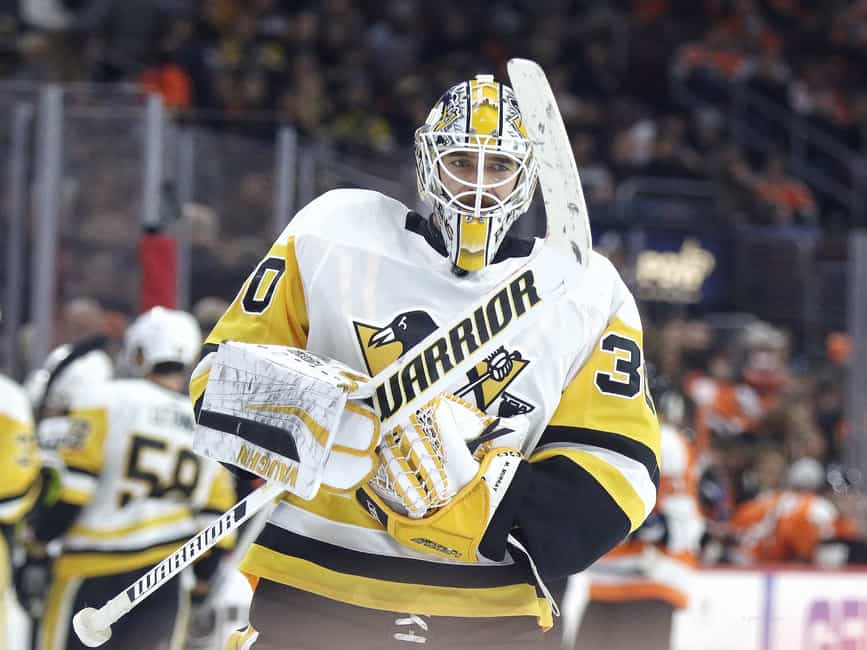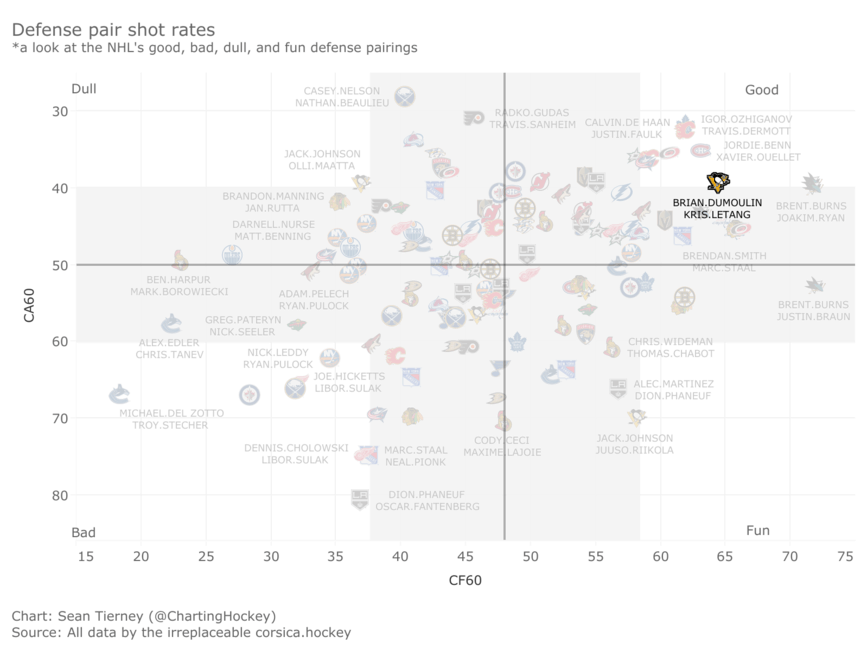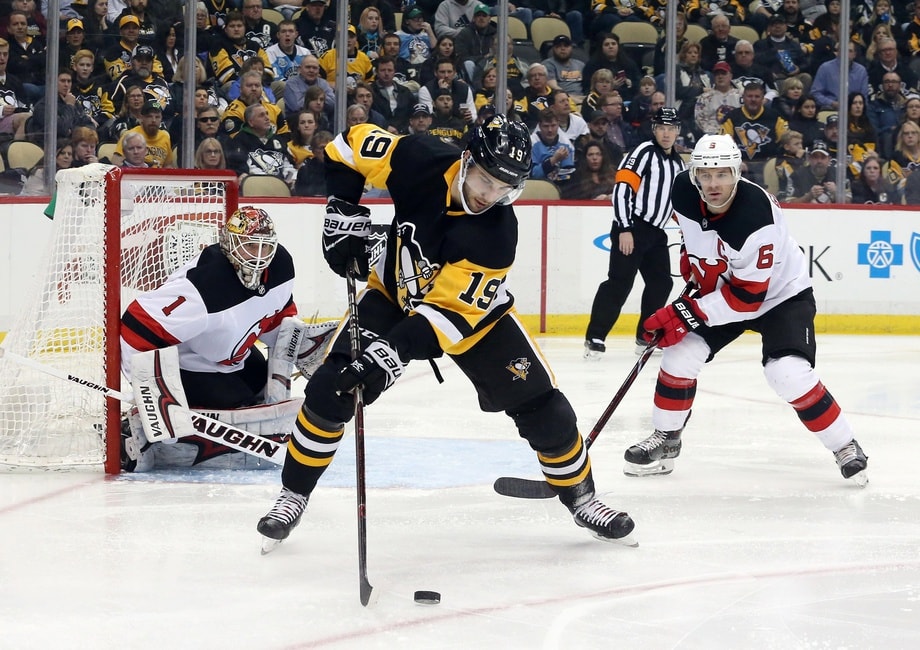It can’t be easy for the Pittsburgh Penguins to get into a rhythm right now. Since opening their season on Oct. 4, they’ve played just six games in 15 days, or once every three days.
Week three of the season was no exception, as the Penguins had another two-game slate. On Tuesday night, the Penguins forgot to show up and were lucky to come away with a point in a 3-2 overtime loss to the Vancouver Canucks. The Penguins rebounded with their best game of the season on Thursday night, shutting out the Toronto Maple Leafs — the league’s highest scoring team — 3-0 at Scotiabank Arena in their first game of a 12-day, four-game road trip.
On the young season, the Penguins have a 3-1-2 record (eight points) in six games. There were a number of positives for the Penguins this week and a few negatives as well. Matt Murray’s impressive return, Kris Letang and Brian Dumoulin carrying the defense, Evgeni Malkin’s hot start and Derick Brassard failing to have an impact on the first line are the focuses of this week’s Penguins Pulpit.
Murray’s Impressive Return
Murray recovered quickly from the third concussion of his career and returned in a big way on Thursday night against the Maple Leafs. The 24-year-old stopped all 38 shots for his first shutout of the season and seventh of his career.

Murray looked confident and was positionally sound all night long. He made a number of stops in close on John Tavares, Nazem Kadri and Zach Hyman. Thursday was a goaltending duel between Murray and Frederik Andersen that could’ve gone either way. Ultimately, it was Murray and the Penguins who came out on top. It’s the best Murray has looked since Game 6 of the 2017 Stanley Cup Final, where he had a 27-save shutout against the Nashville Predators to clinch the Cup.
After a rough beginning to 2018-19, which saw him record a 1-1-0 record, .831 save percentage (SV%) and 5.47 goals against average (GAA) in two games before suffering the concussion, there were legitimate concerns surrounding Murray. How will his long-term health be? Will he be the same player when he returns? He silenced those concerns for one night, at least.
The winning effort moves him to 2-1-0 with a .893 SV% and 3.65 GAA in three games. It’d be premature to say Murray is back to his old self after one game, but it’s a significant step in the right direction for the Penguins’ No. 1 netminder.
Letang, Dumoulin Pairing Among the Best in NHL
Letang was written off by many after an up-and-down 2017-18 campaign which saw him return from major neck surgery. On one hand, his offensive ability was still there, with 51 points in 79 games; on the other, Letang was the definition of inconsistent and looked lost at times.
After a full and healthy offseason, Letang has regained his status as one of the best defensemen in the NHL. The difference between last season and this season is night and day for the 31-year-old. Letang is closing off passing lanes, being physical with the opponent’s best players, and making all the right reads defensively and offensively. In addition to his rebound defensively, Letang became the Penguins’ all-time leader in points among blueliners on Oct. 6 and scored his 100th career goal on Thursday night. Overall, Letang has eight points (four goals, four assists) in six games to begin the 2018-19 season.

The Penguins are also controlling the possession at five-on-five when Letang is on the ice, with a 57.49 CF% in his 120:51 of ice time. He’s also been on the ice for 29 high danger attempts and 16 against (64.44%). Additionally, Letang’s been on the ice for a team-high 62 scoring chances for, compared to 44 against; as well as being on the ice for a team-leading eight goals at five-on-five and six against (57.14 GF%).
Related: Penguins’ Letang Will Rebound in 2018-19
While Letang leads the Penguins in a number of categories, his defensive partner, Dumoulin has also started the season strong despite dealing with an injury near the end of the preseason. The 27-year-old Dumoulin isn’t nearly as talented offensively as Letang — few defensemen are — but he may be the Penguins best shutdown defender.

Since earning a full-time NHL role during the 2015-16 season, Dumoulin has elevated his status from steady presence to one of the more underrated players in the league. When Letang missed the 2017 playoffs, Dumoulin slid in as the Penguins top defenseman and didn’t miss a beat; despite breaking and rebreaking his right-hand multiple times. His efforts earned him the six-year, $24.6 million contract he signed in July 2017, keeping him in Pittsburgh until 2023.
Letang’s return to form has helped Dumoulin take his game to another level in 2018-19, as he’s more active in the offensive zone while maintaining his shut down play in his own zone. With Dumoulin on the ice, the Penguins are controlling 58.3 percent of the shot attempts (130 CF, 90 CA), 58 percent of the scoring chances (54 SCF, 39 SCA) and 66.7 percent of the high-danger attempts (24 HDCF, 12 HDCA).
Dumoulin and Letang have played 179 games together since 2015-16, and in 1,722 minutes the two have controlled 54.9 percent of attempts (1783 CF, 1465 CA) — fifth among pairs who’ve spent 1,500 minutes together — which is plus-3.78% relative to their teammates. They have been victimized by Penguins goaltending, though, with a 45.86 percent goals for (72 for, 85 against), compared to an expected GF% of 55 (83xGF, 68xGA).
In 2018-19, the Letang and Dumoulin have played their best hockey together. In 97 minutes, the pair has a 61.7 CF% (119 CF, 74 CA) — seventh among pairings with 50 minutes together — plus-21.46 % relative to their Penguins teammates and an xGF% of 59.7% (5.09 xGF, 3.43 xGA). So how do they stack up to other pairings around the league?

With Justin Schultz’s injury and bad play from Jack Johnson, Olli Maatta and Jamie Oleksiak, the Penguins will have to rely heavily on Dumoulin and Letang. So far, the returns have been positive.
Malkin off to the Best Start of His Career
Earlier this week, Malkin said he thinks the Maple Leafs’ center duo of Auston Matthews and John Tavares could overtake him and Sidney Crosby as the best one-two punch in the NHL. It doesn’t mean he’s not going to fight to retain the title, though.
“At the same time, we’re still trying to be the best every game. We’re both over 30 years old, but the last three years we’ve still been playing unbelievable. Maybe we’re not dominating every shift, but now we have more experience. Now we understand what it takes in the playoffs.”
After a three-point effort (two goals, one assist) in Thursday night against the Maple Leafs, the 32-year-old is off to the best start of his career with 12 points (three goals, nine assists) in the Penguins’ first six games. Malkin also leads the league with a trio of three-point games. It’s his best output through six games since his rookie season, when he had 11 points (seven goals, four assists). He’s been his usual self to start 2018-19, fighting off defenders with ease, controlling the offensive zone and causing a matchup nightmare for opponents. Malkin also seems to have added another skill to his arsenal, faceoffs. After winning just 43.6% of faceoffs entering the season, he’s won 58.2% of his draws so far. If getting older is supposed to result in declining play, Malkin isn’t showing it.

In fact, Malkin’s has been more productive in his 30s on a per-game basis than he was in his 20s. From 2006-07 to 2015-16 — his age 20-29 seasons — Malkin had 760 points (295 goals, 465 assists) in 644 games for an average of 1.18 points per game (P/GP). Since turning 30 prior to the 2016-17 season, Malkin has 182 points (78 goals, 104 assists) in 146 games (1.25 P/GP). For his career, the Russian center has 942 points (373 goals, 569 assists) in 790 games (1.19 P/GP).
Malkin’s hot start has him within striking range of three major career milestones: 400 goals, 600 assists and 1,000 points. He’ll reach them barring a significant injury – Malkin needs just 27 goals, 31 assists and 58 points over the remaining 76 games to join the three clubs.
Related: The NHL’s Most Underrated Superstar
Brassard on the First Line Isn’t Working
The Brassard-to-wing experiment is not working for the Penguins, and they need to abandon it. When they acquired Brassard in February, it was to give them unmatched depth down the middle. Moving him to the wing on the first line with Crosby and Jake Guentzel not only doesn’t work — because it forces Guentzel to his off-wing; it also makes the bottom-six weaker than it should be. Riley Sheahan has to handle a top-nine role — which he can do — but he doesn’t have as much of an impact as Brassard. Move Sheahan to the fourth line and keep Brassard on the third and it makes matchups more difficult for opponents.

Head coach Mike Sullivan started the experiment last weekend in Montreal and briefly went away from it on Thursday night before reuniting Brassard with Crosby and Guentzel in the third period. He just isn’t having the impact he was expected to have, with just one goal in six games so far.
In just under 32 minutes together, the trio has a five-on-five CF% of 51.7 (30 CF, 28 CA), an xGF of .93, compared to an xGA of 1.19. In addition to looking out of place and sluggish with them, Crosby and Guentzel have CF%’s of 60.18 and 59.63 away from Brassard, respectively. It’s early, but Brassard looks better as a center and it should stay that way for the Penguins.
He doesn’t seem to mind playing third-line minutes, though. “I mean, how could I complain about playing behind two centres when they’re the two best centres in the league?” he told Sportsnet’s Gare Joyce at the beginning of the season.
One group Brassard has looked good with though is the line of him, Bryan Rust and Dominik Simon. In 23 minutes together, they have a CF% of 61.2 (23 CF, 14 CA), xGF of 1.05 and an xGA of .79. Brassard is a talented player, and he’s going to make an impact for the Penguins, but it’s not going to be on the first line.
Overall, it was a good week for the Penguins. Murray had a strong return, Letang and Dumoulin are playing at an elite level and Malkin is at the height of his game. Consistency in the regular season has been a problem for the Penguins in the past, but they ended the week well and have a chance to carry the momentum over to the Western swing of their Canadian road trip.
What’s Up Next:
Oct. 23: @ Edmonton
Oct. 25: @ Calgary
Oct. 27: @ Vancouver
Leading scoring of the week: Evgeni Malkin (two goals, two assists)
Three Stars:
- Evgeni Malkin
- Kris Letang
- Matt Murray
What did you think of the Penguins third week of action? Let us know in the comment section.
Advanced Statistics: NaturalStatTrick.com and Corsica.Hockey